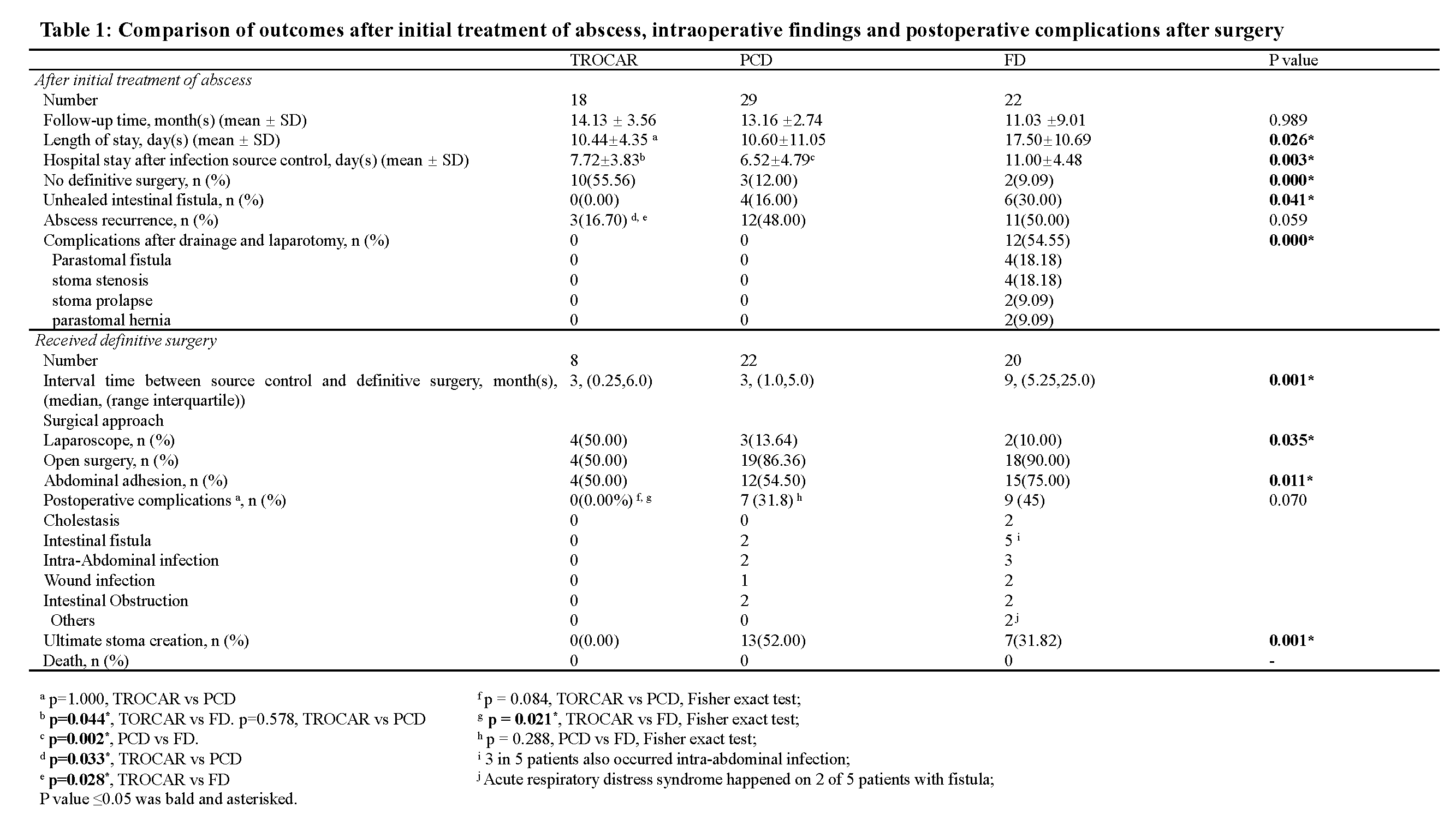TROCAR PUNCTURE WITH SUMP DRAIN: A BETTER MANAGEMENT FOR INTRA-ABDOMINAL ABSCESS IN CROHN'S DISEASE PATIENTS
Juanhan Liu*1, Wenbin Gong2, Peizhao Liu1, Yun Zhao3, Jianan Ren4, Xiuwen Wu4, Yangguang Li1
1Nanjing University, Nanjing University, Nanjing, Jiangsu, CN, academic, Nanjing, Jiangsu, China; 2Southeast University, Nanjing, Jiangsu, China; 3Nanjing BenQ Medical Center, Nanjing, Jiangsu, China; 4East Region Military Command General Hospital, Nanjing, Jiangsu, China
Background
Intra-abdominal infection is a common complication occurred on more than 30% of Crohn's Disease (CD) patients. Percutaneous catheter drainage (PCD) is recommended as primary approach, which carries a risk of inadequate drainage when the pus is thick or more necrosis exists. Up to 70% patients using PCD cannot avoid subsequent bowel resection. What kind of drainage way to get better postoperative outcomes is also non-negligible.
Objective
This study aims to propose a trocar puncture with sump drainage for treatment of intra-abdominal abscess in CD patients and compare it with conventional PCD and surgical intervention.
Methods
Trocar puncture using sump drain was a procedure using a 10-mm double-lumen irrigation-suction catheter (sump drain) to provide continuous irrigation with sterilized water and suction functions under negative pressure (Figure 1). The whole device was placed by a laparoscopic trocar puncture under the imaging guidance.
CD patients with intra-abdominal abscess admitted to our hospital from 2011 to 2020 were identified retrospectively and divided into trocar puncture with sump drain (TROCAR), traditional percutaneous thin-needle puncture with catheter drainage (PCD) and fecal diverting (FD) surgery group according to ways of treating abscess. Chi-square tests, Fisher's exact tests, ANOVA and Wilcoxon rank sum tests were conducted to compare final outcomes, risk factors for abscess recurrence and postoperative complications among three groups. All postoperative events were assessed and graded by the Clavien-Dindo classification, and ?-? was out of consideration with no need of surgical, endoscopic or radiological intervention.
Results
A total of 69 patients were included and divided into trocar (n=18), PCD (n=29), and FD (n=22) group. Four patients in the PCD group were transferred to receive fecal diverting surgery due to initial treatment failure. Incidence of abscess recurrence was significantly higher in the PCD (48%) and FD (50%) group compared to patients using trocar puncture with sump drain (16.7%).
There were 8 in TROCAR, 22 in PCD, and 20 patients in the FD group received enterectomy. The incidence of intraoperative diagnosis of abdominal adhesion was significantly lower in TROCAR group (n=4, 50%) compared to FD (n=15, 75%). None of patients in TROCAR had ultimate stoma and the incidence of postoperative complications were statistically lower (0%(TROCAR) vs. 31.8%(PCD) vs. 45%(FD) (Table 1). Way of initial treating on abscess was significantly correlated with abscess recurrence and postoperative complications.
Conclusions
Trocar puncture with sump drain was recommended for management of intra-abdominal abscess in Crohn's disease patients. It would result in lower incidence of abscess recurrence and better outcomes after management of abscess and subsequent definitive surgery.
Figure 1
Table 1
Back to 2022 Posters
